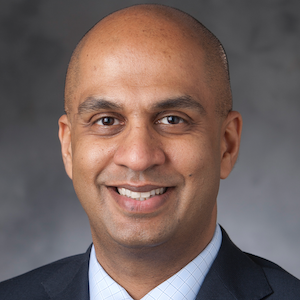News
Article
Retinal Artery Occlusion Linked to Increased Risk of Death, Vascular Events
Author(s):
Patients with RAO had a higher risk of death, stroke, and myocardial infarction at both short-term and long-term intervals compared to matched controls diagnosed with cataract.
Pirthvi Mruthyunjaya, MD
Credit: Stanford University

New research reported an increased risk of death, stroke, and myocardial infarction among patients with retinal artery occlusion (RAO), in both the short- and long-term, compared with matched controls diagnosed with cataract.1
Investigators, led by Pirthvi Mruthyunjaya, MD, of the Byers Eye Institute at Stanford University, found the overall absolute risk remained relatively low in the short-term period and lower than previously reported evidence, although they noted some methodical differences compared with historical study designs.
However, in the long-term, there remained an overall increased risk of vascular events, suggesting the importance of cardiovascular workup and comprehensive monitoring among patients with RAO.
“This study confirmed the increased risk of death, stroke, and myocardial infarction following RAO when compared with a control population that was matched for age, sex, race, and systemic comorbidities,” investigators wrote.
Guidelines from the American Academy of Ophthalmology (AAO) recommend all patients with RAO receive an immediate referral to an emergency department or stroke center, given its known association with stroke.3 There are no proven therapies for associated vision loss from RAO – instead, management is targeted instead at averting future complications associated with retinal ischemic and preventing future secondary vascular events.
Using the large, aggregated TriNetX electronic health record network, Mruthyunjaya and colleagues assessed the risk of death and vascular ischemic events, including stroke and myocardial infarction, after RAO, in comparison with a matched control population.1 The retrospective cohort was chosen from the aggregated deidentified data of >111 million patients from January 2003 to April 2023.
All included patients with RAO had ≥1 year of follow-up after the RAO event. A control population was created and included patients diagnosed with cataract. Patients were excluded from the analysis if they had a stroke or myocardial infarction in the 2 years prior to the RAO event.
Propensity score matching was performed on both cohorts to control for age, sex, race, and systemic comorbidities. The main outcome for the analysis was the rates of stroke, myocardial infarction, or death at 2 weeks, 30 days, 1 year, 5 years, and 10 years after RAO, compared with the matched controls. Overall, a total of 34,874 patients with ≥1 year of follow-up were included in the RAO cohort, with a mean age at the time of RAO event of 66 years.
Upon analysis, the rate of death after RAO diagnosis was higher than after cataract diagnosis at all time points. Investigators noted the RR for death was approximately double relative to the control cohort, and the overall risk difference was relatively small at all time points:
- 2 weeks: 0.14% vs. 0.06% (relative risk [RR], 2.45; 95% CI, 1.46 - 4.12; P <.001)
- 30 days: 0.29% vs. 0.14% (RR, 2.10; 95% CI, 1.49 - 2.97; P <.001)
- 1 year: 3.51% vs. 1.99% (RR, 1.78; 95% CI, 1.61 - 1.94; P <.001)
- 5 years: 22.74% vs. 17.82% (RR, 1.28; 95% CI, 1.23 - 1.33; P <.001)
- 10 years: 57.86% vs. 55.38% (RR, 1.05; 95% CI, 1.02 - 1.07; P <.001)
Additionally, the risk of stroke was higher in the RAO group than in the control cohort. The relative risk for stroke was approximately 21-fold in the first 2 weeks, 14-fold within 30 days, and 5-fold within 1 year in patients diagnosed with RAO compared with controls:
- 2 weeks: 1.72% vs. 0.08% (RR, 21.43; 95% CI, 14.67 - 31.29; P <.001)
- 30 days: 2.48% vs. 0.18% (RR, 14.18; 95% CI, 10.94 - 18.48; P <.001)
- 1 year: 5.89% vs. 1.13% (RR, 5.20; 95% CI, 4.67 - 5.79; P <.001)
- 5 years: 10.85% vs. 4.86% (RR, 2.24; 95% CI, 2.09 - 2.40; P <.001)
- 10 years: 14.59% vs. 9.18% (RR, 1.59; 95% CI, 1.48 - 1.70; P <.001).
Meanwhile, the relative risk for myocardial infarction was 3-fold higher within the first 2 weeks, 2.6-fold higher within 30 days, and 1.7-fold higher within 1 year among the RAO cohort. However, the overall risk difference was relatively small at all time points.
- 2 weeks: 0.16% vs. 0.06% (RR, 3.00; 95% CI, 1.79 - 5.04; P <.001)
- 30 days: 0.27% vs. 0.10% (RR, 2.61; 95% CI, 1.78 - 3.83; P <.001
- 1 year: 1.66% vs. 0.97% (RR, 1.72; 95% CI, 1.51 - 1.97; P <.001)
- 5 years: 6.06% vs. 5.00% (RR, 1.21; 95% CI, 1.12 - 1.31; P <.001)
- 10 years: 10.55% vs. 9.43% (RR, 1.12; 95% CI, 1.04 - 1.21; P = .003)
Mruthyunjaya and colleagues noted more research is needed to determine the best method to triage patients after RAO, and the potential need for multidisciplinary evaluation with long-term follow-up after RAO.
“Further studies are needed to assess the best method to triage patients after RAO to determine if emergency inpatient assessments vs expedited outpatient workup is most appropriate for management of patients with RAO in the acute setting," they wrote.
References
- Wai KM, Knapp A, Ludwig CA, et al. Risk of Stroke, Myocardial Infarction, and Death After Retinal Artery Occlusion. JAMA Ophthalmol. Published online October 26, 2023. doi:10.1001/jamaophthalmol.2023.4716
- Vestergaard N, Torp-Pedersen C, Vorum H, Aasbjerg K. Risk of stroke, myocardial infarction, and death among patients with retinal artery occlusion and the effect of antithrombotic treatment. Transl Vis Sci Technol. 2021;10(11):2. doi:10.1167/tvst.10.11.2
- Olsen TW, Pulido JS, Folk JC, Hyman L, Flaxel CJ, Adelman RA. Retinal and ophthalmic artery occlusions preferred practice pattern. Ophthalmology. 2017;124(2):120-P143. doi:10.1016/j.ophtha.2016.09.024





